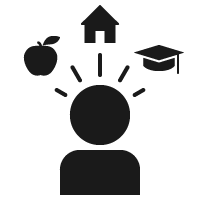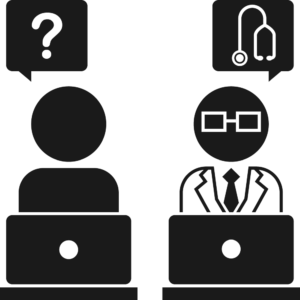Authentic Assessment in the Online Classroom

 Assessment is a critical component of the online classroom. It provides students with an idea of their progress in a course, identifies individual strengths and weaknesses, and ultimately serves as the measure of whether students achieve the course’s learning objectives. Although each of these characteristics serves a valuable instructional or pedagogical function, it’s also important that assessments engage students and prepare them with the skills they’ll need in future courses, practicums, and even their careers.
Assessment is a critical component of the online classroom. It provides students with an idea of their progress in a course, identifies individual strengths and weaknesses, and ultimately serves as the measure of whether students achieve the course’s learning objectives. Although each of these characteristics serves a valuable instructional or pedagogical function, it’s also important that assessments engage students and prepare them with the skills they’ll need in future courses, practicums, and even their careers.
Assessment isn’t just important from a student perspective. With the online marketplace becoming increasingly crowded, it’s critical that institutions ensure they are offering the courses and experiences that students are looking for.
In their survey of more than 1,500 past, present, and prospective online college students, Magda and Aslanian (2018) found that 74% of online college students are pursuing their program for career-focused reasons, such as transitioning to a new career, updating the skills required for their current job, increasing wages, or meeting employers’ requirements.
Because the majority of online students are career-focused, courses and degree programs must provide those ties to the real world for institutions to stand out in the online landscape. Given its importance to the online classroom, assessment can be a great starting point for integrating this type of relevance into your course.
Authentic assessment is the idea of using creative learning experiences to test students’ skills and knowledge in realistic situations. Authentic assessment measures students’ success in a way that’s relevant to the skills required of them once they’ve finished your course or degree program. In this article, we’ll discuss the benefits and challenges of this type of assessment and how you can incorporate authentic assessment in your online course.
What Is Authentic Assessment?
 Before we dig too far into how to create an authentic assessment, let’s look at what makes an assessment authentic. Wiggins (1998) identifies a few key criteria:
Before we dig too far into how to create an authentic assessment, let’s look at what makes an assessment authentic. Wiggins (1998) identifies a few key criteria:
- It’s realistic.
- It requires judgement and innovation.
- It asks the student to “do” the subject.
- It replicates or simulates the contexts in which adults are “tested” in the workplace, in civic life, and in personal life.
- It assesses the student’s ability to efficiently and effectively use a repertoire of knowledge and skill to negotiate a complex task.
- It allows appropriate opportunities to rehearse, practice, consult resources, and get feedback on and refine performances and products.
Simply put, an authentic assessment is one that requires students to apply what they’ve learned in a new, complex circumstance or situation. Typically, this can take one of two forms: real-world assessments that require students to engage in actual situations in their field, or realistic assessments that are relevant in nature but have students engage in situations that mimic the real world (e.g., a case study).
Regardless of the type, authentic assessment is often coupled with opportunities for rehearsal and/or practice. Authentic assessments are often scaffolded throughout a course and allow the instructor to provide feedback that students can then implement in subsequent drafts. Unlike traditional assessments (such as essays and multiple-choice exams), authentic assessments ask students to engage in scenarios or practices that are complex, realistic, and sometimes messy.
Benefits of Authentic Assessment
![]() Shank (2009) identifies a few key challenges of assessments in the online environment: expecting a bell curve, using the wrong type of assessment (performance assessments vs. test assessments), not creating valid (enough) assessments, and using poorly written multiple-choice tests. Although authentic assessment is unlikely to overcome all of these challenges, it offers a number of benefits in an online course.
Shank (2009) identifies a few key challenges of assessments in the online environment: expecting a bell curve, using the wrong type of assessment (performance assessments vs. test assessments), not creating valid (enough) assessments, and using poorly written multiple-choice tests. Although authentic assessment is unlikely to overcome all of these challenges, it offers a number of benefits in an online course.
Notably, authentic assessment breaks the traditional paradigm of multiple-choice or automatically scoring tests and quizzes, which can lead students to believe that learning means staying up all night and cramming to memorize terms or expected answers. Instead, authentic assessments tend to be more student centered, as they ask students to demonstrate their learning through hands-on activities. Rather than asking students to memorize and recall facts, authentic assessments ask students to actively participate in situations that require them to apply the principles they’ve learned about in the instructional material. Thus, learning isn’t about recalling; it’s about performing, which, ideally, will motivate students to engage in the course and succeed in their endeavors.
Drawbacks of Authentic Assessment
As beneficial as authentic assessments can be, they do present challenges as well. First and foremost, authentic assessments require more time for both students and instructors than traditional assessments. For students, authentic assessments typically take longer to complete than an average quiz or test. Because these types of assessments are task based, they might be scaffolded over a number of modules or some other period of time. In addition, students might be more accustomed to traditional assessment, meaning that despite the advantages we’ve discussed, they might need some time to adjust to this new method.
For instructors, time is also of concern. Developing an authentic assessment can be an intense experience that requires course writers to identify and/or research relevant tasks, ensure that those tasks are applicable to students in different areas, and align those tasks with learning objectives and instructional materials. Also, given that students in online courses tend to be in a variety of geographic locations, it can be difficult to build an authentic assessment that’s relevant to everyone. This challenge can vary by discipline, but it’s important for course writers to remember that their students can be from anywhere.
In addition, unlike many traditional assessments, grading an authentic assessment is largely subjective. Because these types of assessments typically address more complex levels of learning, grading will likely take much longer. Authentic assessments typically require detailed, personalized, and specific feedback, meaning that, as beneficial as they can be for students and your course, they will require additional time to design and implement.
| Field |
Authentic Assessment |
| Education | Create a classroom management plan and/or lesson plan for the student’s subject matter and/or intended audience. |
| Nursing | Assess a mock patient’s health and plan and implement that patient’s care. |
| Business | Develop a business plan for a company in the student’s location and desired field. |
| Computer Science |
Troubleshoot faulty code or create a website or application. |
| Exercise Science | Record and analyze a mock client’s diet and come up with a nutrition and/or exercise plan. |
How to Develop an Authentic Assessment
Now that we’ve explored the benefits and drawbacks of authentic assessment and looked at a handful of examples, let’s move on to the steps involved in designing one. The following steps, based on those developed by the University of Florida’s Center for Instructional Technology and Training (2018), can help set you on your way toward developing an authentic assessment that addresses your learning objectives, enhances your course, and meets your students’ needs.
Identify Learning Objectives
 Your learning objectives are the cornerstone of your course; they communicate what students should be able to do and what skills they’ll develop during the course. Thus, it goes without saying that developing an authentic assessment should begin with these objectives. By starting this process with an objective in mind, you ensure that the authentic assessment you’re developing will align with the objective and any corresponding instructional material.
Your learning objectives are the cornerstone of your course; they communicate what students should be able to do and what skills they’ll develop during the course. Thus, it goes without saying that developing an authentic assessment should begin with these objectives. By starting this process with an objective in mind, you ensure that the authentic assessment you’re developing will align with the objective and any corresponding instructional material.
In most instances, you’ll want to focus on a macro objective—that is, an objective that illustrates what students will be able to do by the conclusion of the course. In a traditional setting, a final exam might be the assessment for a macro objective.
When you look at your objectives, it’s also important to keep relevance in mind. After all, one of the major benefits of an authentic assessment is how it allows students to engage in a relevant or new environment, so you’ll want to make sure that your learning objectives lend themselves to that type of activity. If your learning objectives are already measurable and student centered, though, this shouldn’t be a problem.
Define Relevant Tasks
After identifying the learning objective(s) you’re looking to measure through your authentic assessment, you can then start defining what students will actually do. Given that the assessment should be, well, authentic, start by looking at what professionals in your field do on a daily basis and how those tasks might relate to your selected learning objective. Although your task doesn’t ultimately have to relate to your field, it should require students to apply themselves in a relevant and new situation. Ultimately, the relevance of your assessment to students’ lives and/or goals should be clear. In fact, it’s helpful to state the relevance explicitly at the outset of the assessment.
If you’re struggling to identify a relevant task, consider starting with the verb of your learning objective. Oftentimes, you’ll find that you’re able to define your task by looking at what the objective asks students to do. For instance, if the objective for a business course is that students will be able to analyze the local and global impact of organizational decisions, consider creating a fictional scenario in which students have to make organizational decisions for a business and analyze the impact of those decisions. Looking at your objective’s verb also ensures that your assessment aligns with your learning objective, which is a pillar of effective course design.
Identify Essential Performance Criteria
If the previous step was to define what students will do to complete your authentic assessment, this step focuses on how you’ll know whether they’ve done it well. After all, just because an authentic assessment doesn’t look like a traditional assessment doesn’t mean that the goal isn’t the same. You still need to have an indication of how well students have performed and whether they’ve achieved mastery.
With this in mind, it’s important for these performance criteria to align with the nature of your task. To return to our business example from earlier, you’d want to make sure that the way you measure students’ performance is reflective of or similar to the expectations they would encounter in a business scenario. For example, you’d want to create performance criteria specific to how students should make the organizational decisions and how accurately and/or appropriately they analyze those decisions. Although students shouldn’t be held to the same standards as professionals in the field (they’re novices, after all), it’s still possible to measure student success in a new and relevant way.
Develop a Rubric
 Rubrics are a powerful tool for many assessment types, and they’re an essential component of authentic assessment. After all, authentic assessments are fairly subjective, and rubrics help ensure instructors are grading fairly and consistently from assessment to assessment and student to student. With this in mind, once you’ve identified the task and essential performance criteria (that is, what students will do and what benchmarks exist to make sure students do it well), the next step is to develop a rubric.
Rubrics are a powerful tool for many assessment types, and they’re an essential component of authentic assessment. After all, authentic assessments are fairly subjective, and rubrics help ensure instructors are grading fairly and consistently from assessment to assessment and student to student. With this in mind, once you’ve identified the task and essential performance criteria (that is, what students will do and what benchmarks exist to make sure students do it well), the next step is to develop a rubric.
You might be thinking that this seems pretty similar to that last step. Well, it is! When designing your rubric, you should use the performance criteria you’ve identified and come up with measurable levels for each. Once you’ve developed your rubric, consider presenting it to students before they begin the assessment. That way, they know what you expect of them and can more readily gauge their own performance.
For more information on rubrics, feel free to check out our article “The Benefits of Rubrics in Online Courses.”
Conclusion
Authentic assessment has the outstanding ability to make a long-lasting impact on not only your course, but also the students enrolled in it. By providing students with an opportunity to test their skills in new and relevant situations, you’ll prepare them for how they’ll be assessed in their professional lives and show them the relevance of your course’s content outside the classroom. With that in mind, here are some of the key takeaways from this article:
- Authentic assessment refers to an assessment that requires students to apply what they’ve learned in a new circumstance or situation, typically one that mirrors what would be expected of them in that discipline or field.
- When preparing an authentic assessment for your course, remember that this kind of assessment will likely take more time on both the students’ and facilitator’s parts.
- Authentic assessments should always align with the course’s learning objective(s).
- When identifying a relevant task for your learning objective(s), consider starting with the objective’s verb. In most cases, this will provide an idea of what actions students should be able to perform.
- Essential performance criteria help frame what performance will look like. Without them, it’s difficult to assess students’ work on a fair and consistent basis. Fortunately, instructors can use these criteria to develop a rubric, which in turn helps them evaluate fairly and consistently.
References
Magda, A. J., & Aslanian, C. B. (2018). Online college students 2018: Comprehensive data on demands and preferences. Louisville, KY: The Learning House, Inc.
Shank, P. (2009, May). Four typical online learning assessment mistakes. In R. Kelly (Ed.), Assessing online learning: Strategies, challenges and opportunities (pp. 4-6). Madison, WI: Magna Publications Inc. Available from https://www.facultyfocus.com/free-reports/assessing-online-learning-strategies-challenges-and-opportunities/
University of Florida. (2018). Authentic assessment in online learning. Retrieved from http://citt.ufl.edu/online-teaching-resources/assessments/authentic-assessment-in-online-learning/
Wiggins, G. (1998). Education assessment: Designing assessments to inform and improve student performance. San Francisco: Joey-Bass Publishers.
